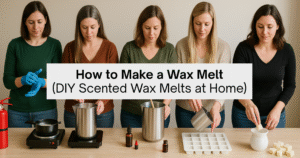No products in the cart.
Candle Scents Proven to Ease Anxiety and Improve Sleep

Disclaimer
We did not conduct experiments for this article. The information presented is synthesized from publicly available research papers and clinical reviews cited in the Sources section.
We curate and contextualize this evidence to explain how candle scents may support mental well-being. This content is for educational purposes only and is not a substitute for professional medical advice, diagnosis, or treatment.
This research article examines how scented candles influence mental health through evidence-based findings. The sense of smell is closely linked to the brain’s limbic system, which governs mood, stress responses, and sleep regulation.
Recent clinical trials and meta-analyses provide measurable data showing that specific scents—such as lavender, jasmine, neroli, and rosemary—can reduce anxiety scores, lower heart rate and blood pressure, improve sleep quality, and enhance cognitive performance.
The discussion also evaluates which fragrance molecules and candle materials are both effective and safe, focusing only on those supported by scientific evidence and approved under international safety standards.
By combining insights from controlled studies with practical usage guidelines, this research highlights how candles, when properly selected and burned, can serve as a complementary tool for mental well-being.
How candle scent can help (what the data say)
1) Anxiety relief (short-term)
A 2021 network meta-analysis of randomized trials (3,922 participants) found that inhaled essential oils reduced anxiety on the Spielberger scales and also lowered physiological stress markers. Pooled effects (oil-by-oil) included:
- Jasmine: mean reduction in state anxiety (SAIS) of –13.61 points (95% CrI –21.32 to –5.90).
- Neroli (Citrus aurantium): mean reduction in trait anxiety (TAIS) of –9.62 points (95% CrI –12.77 to –6.49).
- Lavender: reductions in systolic BP by –6.83 mmHg (95% CrI –9.55 to –3.86) and heart rate by –3.43 bpm (95% CrI –5.15 to –1.66), consistent with calming/autonomic down-shift.
A representative single RCT in labor used 4 mL of 8% neroli distillate on gauze (replaced every 30 min) and observed Spielberger state-anxiety scores ~11 points lower than control at 3–4 cm dilation (45.3 ± 1.2 vs 56.4 ± 1.1; p<0.001) and ~16 points lower at 6–8 cm (43.2 ± 1.7 vs 59.3 ± 1.6; p<0.001).
Takeaway (for candles): When the same aromas are delivered by ambient air (as with a well-made candle), clinically meaningful short-term anxiety reductions are plausible, especially for jasmine, neroli, and lavender profiles. The magnitudes above are from human trials using inhalation exposure.
2) Sleep quality
A 2024 meta-analysis (n=671; 13 RCTs) reported that aromatherapy improved global sleep quality (SMD –0.72, 95% CI –1.03 to –0.41). The inhalation-only subgroup showed a larger effect (SMD –0.97, 95% CI –1.22 to –0.73); within oils, lavender achieved SMD –0.88 (95% CI –1.11 to –0.64).
Takeaway: Lavender-forward candle scents (linalool/linalyl acetate dominant) are the best-supported choice for sleep preparation.
3) Attention and memory (alerting/cognitive effects)
In a controlled study (n=20) with rosemary aroma, blood 1,8-cineole levels correlated with better task performance: serial-3 subtraction speed (r = 0.48), serial-7 speed (r = 0.65), word recall (r = 0.45), and digit span (r = 0.47); higher cineole also correlated with slower reaction time on a vigilance task (r = 0.62), reflecting a speed-accuracy trade-off typical for alerting stimuli.
A larger RCT (n=144) showed peppermint increased alertness and enhanced memory vs control, while ylang-ylang impaired memory and slowed processing (peppermint is safe; ylang-ylang is not recommended for performance tasks).
Takeaway: For focus/alertness, rosemary-like accords rich in 1,8-cineole have the clearest numeric links to improved performance; evidence for peppermint is mixed but suggestive in some trials.
Which scents & aroma chemicals are supported?
All listed materials below are commonly used fragrance ingredients considered safe at typical candle use levels under the IFRA Code of Practice (Category 12: candles/home fragrance). (IFRA is the global safety framework for fragrance—see sources.)
Lavender profiles → Anxiety ↓; Sleep ↑
- Key chemicals: linalool, linalyl acetate (both well-characterized and widely permitted in Category 12).
- Numbers: anxiety reductions (BP –6.83 mmHg; HR –3.43 bpm) and sleep SMD –0.88 to –0.97 with inhalation.
Jasmine profiles → Anxiety ↓
- Key chemicals: benzyl acetate, linalool, indole (used well within IFRA).
- Numbers: SAIS –13.61 (95% CrI –21.32 to –5.90).
Neroli / Bitter orange blossom → Anxiety ↓; calming
- Key chemicals: linalool, linalyl acetate, nerolidol.
- Numbers: TAIS –9.62 (95% CrI –12.77 to –6.49); labor RCT reductions of ~11–16 Spielberger points using 8% distillate on gauze.
Damask rose profiles → Anxiety ↓; soothing effect
- Key chemicals: phenethyl alcohol, citronellol, geraniol (per IFRA limits).
- Numbers: SAIS –6.78 (95% CrI –10.94 to –2.19).
Rosemary-like (1,8-cineole–forward) → Alertness/working memory ↑
- Key chemical: 1,8-cineole (eucalyptol).
- Numbers: correlations with performance (r = 0.45–0.65 across tasks); effect sizes up to r² ≈ 0.38 on some outcomes in follow-ups.
(Note: I’ve intentionally excluded materials with problematic risk profiles for home fragrance or those associated with performance decrements.)
Candle materials & indoor-air numbers (what’s safe in practice?)
1. Wax types
A comprehensive 2021 chamber study compared multiple unscented and scented candles (paraffin, stearin, soy, palm, beeswax) and measured gas/particle emissions under controlled ventilation (30 m³ room, air-exchange 0.5 h⁻¹, 4 h/day, 4 days/week use scenario). Findings:
- No single wax was consistently “cleaner”; scented candles emitted more VOCs than unscented (as expected for added fragrance).
- Typical carbonyl emission rates ranged roughly 7–182 µg/h per candle.
- Most pollutants met indoor guideline values; compliance factors were generally < 1 (exceptions: some cases for NO₂, acrolein, benzo[a]pyrene under unfavorable conditions).
Implication: Choose a well-formulated candle from a reputable maker; wax choice (soy vs beeswax vs paraffin) is not the dominant factor for indoor air quality—the bigger levers are fragrance load, wick fit, and how you burn it.
2. Benzene & formaldehyde context
WHO’s indoor benzene risk benchmark for a 1-in-1,000,000 lifetime cancer risk is 0.17 µg/m³ (long-term exposure). In the candle study above, the median benzene compliance factor was 0.26 (relative to the WHO guide value), indicating typical use scenarios stayed within guideline comparisons, while sources like incense or tobacco smoke can reach much higher benzene levels (tens to >100 µg/m³).
3. Wicks (what’s acceptable)
Lead-core wicks are banned in the U.S.; federal rule: > 0.06% lead in the metal core is prohibited (since 2003). Choose cotton/paper wicks from reputable brands.
4. Fragrance safety framework (IFRA)
Candles fall under IFRA Category 12. IFRA Standards (51st amendment, 2023) are global safety limits/criteria for 263 restricted fragrance compounds, and IFRA explicitly recognizes Category 12 applications (candles/home fragrance). Ask brands for IFRA Certificates of Conformity for their fragrance mixtures.
How to burn for benefits while minimizing by-products
- Trim the wick to ¼ inch (≈ 6 mm) before lighting; long wicks increase soot and flare.
- Session length: follow the maker’s label; common industry guidance is ≤ 4 hours per session, then allow cooling.
- First burn: about 1 hour per inch of candle diameter (e.g., a 3-inch jar ≈ 3 hours) to set an even melt pool.
- Placement: keep candles ≥ 3 inches apart and away from drafts to prevent sooting.
- Ventilation: normal room air-exchange ≈ 0.5 h⁻¹ was used in the 2021 emissions study; improving ventilation further reduces pollutant build-up.
Who should be cautious?
Fragrance sensitivity is real: nationally representative surveys report ~30–35% of adults experience health symptoms (e.g., headache, respiratory irritation) from fragranced products; prevalence is higher in people with asthma. If you’re fragrance-sensitive or asthmatic, prefer unscented products or ensure strong ventilation.
Putting it together (evidence-based picks)
- For winding down / sleep: Lavender-forward candle (linalool/linalyl acetate) used in the hour before bed; evidence shows SMD –0.88 to –0.97 for sleep quality with inhalation aromatherapy. Keep burn sessions ≤ 4 h.
- For acute stress relief: Jasmine or neroli profiles; meta-analytic reductions up to –13.6 SAIS points (jasmine) and –9.6 TAIS points (neroli). If you prefer citrus-floral notes, neroli blends are well supported.
- For focus sessions: Rosemary-like (cinéole-rich) accords; higher 1,8-cineole exposure correlated r = 0.45–0.65 with improved working memory/processing on lab tasks.
Conclusion
In conclusion, the evidence demonstrates that scented candles are more than decorative objects; they can play a measurable role in improving mental health.
Clinical data show that lavender and neroli significantly reduce anxiety and improve sleep, jasmine lowers stress scores by over ten points on standard scales, and rosemary’s active compound, 1,8-cineole, enhances working memory and alertness.
Importantly, safe use depends on selecting candles made with approved waxes, cotton or paper wicks, and IFRA-compliant fragrances, and following best practices for ventilation and burn time.
When these factors are considered, scented candles provide a scientifically supported, safe, and accessible way to reduce stress, promote relaxation, and support focus, making them a meaningful addition to holistic approaches to mental wellbeing.
Sources
- Essential oils for treating anxiety: a systematic review of randomized controlled trials and network meta‑analysis (Tan et al., 2023): https://pubmed.ncbi.nlm.nih.gov/37325306/
- Plasma 1,8‑cineole correlates with cognitive performance following exposure to rosemary essential oil aroma (Moss & Oliver, 2012): https://pmc.ncbi.nlm.nih.gov/articles/PMC3736918/
- PubMed abstract for the same study: https://pubmed.ncbi.nlm.nih.gov/23983963/
- Inhalation aromatherapy for the treatment of comorbid… (Frontiers in Psychiatry, 2025): https://www.frontiersin.org/journals/psychiatry/articles/10.3389/fpsyt.2025.1485693/full
- Effects of aromatherapy with Lavender‑Neroli oil and music in pediatric dental anxiety (Rama Abdalhai et al., 2024): https://doi.org/10.1038/s41405-024-00186-8
- Aromatherapy and Essential Oils in Pediatric Care (Silva et al., 2025): https://bjhealtharomatherapyessentialoil.com/index.php/bjhaeo/article/view/bjhae21

Nav Preet is the founder and creative soul behind Karigar Candles. Inspired by heritage, nature, and the warmth of handmade artistry, she crafts candles that do more than glow—they evoke emotion. Through this blog, she shares her love for scents, styling, and mindful living, one flame at a time.
Creative Head at Karigar Style







